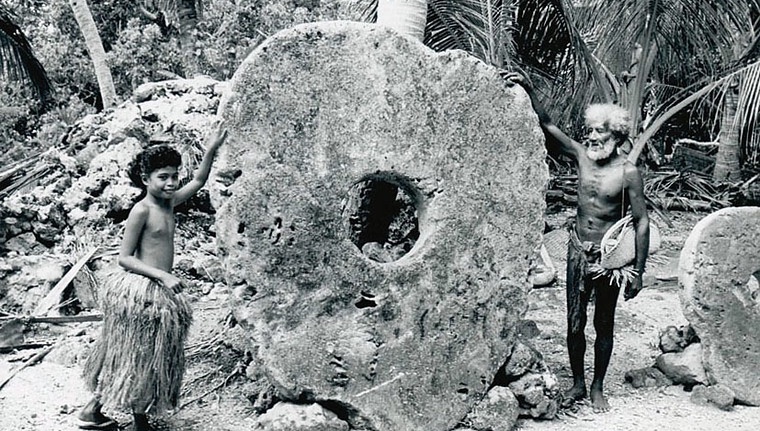Yapese Rai Stones

Going forward, I’ll be making posts about my ongoing projects. If any readers have advice, I welcome it. One such project, and the topic of this post, regards the Rai stones of the Yapese culture. The Yapese are an island culture in the pacific (Micronesia); they’ve inhabited the same islands for, at least, two thousand years. They’ve been of interest to economists in the past because they appear to use giant stones, weighing upwards of a ton, as money.
These stones typically have holes in the middle, which allow for easier transportation via ropes; though, they are not moved often. While Rai stones are often traded within their owners’ lifetimes, they typically aren’t moved because of the cost associated. In one interesting case, a Rai stone sank to the bottom of the ocean during an inter-island trip; the Yapese continued trading the stone regardless, as they all agree it still exists. Ownership of Rai stones is established by oral tradition
When Germany took control of the islands in the early 20th century, they tasked the Yapese with building roads. The Yapese did not. Germany decided to assess fines on the tribal leaders, but there was no apparent money with which to collect fines. So, the Germans simply painted a black “x” on Rai stones to indicate government ownership (seizure); this prompted the roads to be built near instantly.
Milton Friedman likens this example to the Federal Reserve’s payment of gold to France in 1923; the Fed simply changed the labeling on drawers holding gold, and suddenly the market was in panic for fear of the dollar losing value. Friedman explains the Rai stones are comparable to Fed vaults because everybody merely agrees that they represent money. Cryptocurrency enthusiasts also use this example to argue against the regression theorem; clearly, these Rai stones do not really have practical value, right?
There are a few problems with these interpretations of Rai stones. First and foremost, the Yapese disagree with it. A Yapese writer indicated that Friedman and other economists do not understand their culture when writing about their Rai stones. In my research, I’ve found a few reasons why this may be the case. For one, Rai stones are not money. That is, they are not used for most transactions; at best, they are auxiliary media. Friedman and others like to mention that Rai stones are traded for food; this is highly disingenuous. I found one example of this occurring, and it was an enormous bulk purchase of grains. By the Yapese’s own admission, Rai stones are too expensive and indivisible to purchase everyday items.
No economist has discovered that Rai stones are used exclusively for alliances and bride-prices. This is reminiscent of Posner’s work on bride-prices, wherein he notes that many primitive societies only use cattle for paying bride-prices. As Posner suggests, it seems that many cultures use cattle exclusively for bride-prices because cattle is often the only item that stores value; that is, they’re worth a lot, and if maintained are also durable. One should remember that not many items are both valuable and durable in primitive cultures; food items, the basic unit of barter economies, are not very durable. It makes sense, then, that any “expensive” purchase would be made with something durable; saving a warehouse of wheat for a purchase has much opportunity cost in a world of starvation, and what use does a fellow vendor have for a thousand pounds of wheat that will expire before they may consume the lot? If the wheat were able to be easily traded, then the wheat would just be money; this was not the case.
The Yapese do not have cattle. They have no items that observably store value, are durable, and allow for large purchases; except for Rai stones. I’m still working through my argument here, but I posit that Rai stones are an intentionally costly investment, meant to signal commitment. This is supported by the fact that Rai stones are exclusively used for transactions wherein trust is involved (bride-prices, alliances). Rai stones are an innovation of the Yapese that allows them to signal costly commitment, without resorting to items that whither or are useless in bulk. Additionally, I think the oral tradition enforcing Rai stone property rights serves as a mechanism that prohibits “false” Rai stones; that is, one cannot merely find a rock and claim it has value, they must buy a Rai stone that has communal standing.
There is still much to ponder on this topic, but it is a fascinating project that I will continue nonetheless.